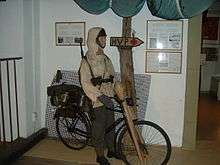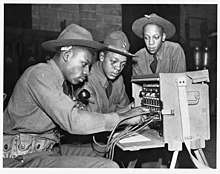Military communications
Military communications or military signals involve all aspects of communications, or conveyance of information, by armed forces. Military communications span from pre-history to the present. The earliest military communications were delivered by runners. Later, communications progressed to visual and audible signals, and then advanced into the electronic age. Examples from Jane's Military Communications include text, audio, facsimile, tactical ground-based communications, naval signalling, terrestrial microwave, tropospheric scatter, satellite communications systems and equipment, surveillance and signal analysis, encryption and security and direction-finding and jamming.[1]

History

In past centuries communicating a message usually required someone to go to the destination, bringing the message. Thus, the term "communication" often implied the ability to transport people and supplies. A place under siege was one that lost communication in both senses. The association between transport and messaging declined in recent centuries.

The first military communications involved the use of runners or the sending and receiving of simple signals (sometimes encoded to be unrecognizable). The first distinctive uses of military communications were called "signals". Modern units specializing in these tactics are usually designated as "signal corps". The Roman system of military communication (cursus publicus or cursus vehicularis) is an early example of this. Later, the terms "signals" and "signaller" became words referring to a highly-distinct military occupation dealing with general communications methods (similar to those in civil use) rather than with weapons.
Present-day military forces of an informational society conduct intense and complicated communicating activities on a daily basis, using modern telecommunications and computing methods. Only a small portion of these activities are directly related to combat actions. Modern concepts of network-centric warfare (NCW) rely on network-oriented methods of communications and control to make existing forces more effective.
Military communications equipment

Drums, horns, flags, and riders on horseback were some of the early methods the military used to send messages over distances. The advent of distinctive signals led to the formation of the signal corps, a group specialized in the tactics of military communications. The signal corps evolved into a distinctive occupation where the signaller became a highly technical job dealing with all available communications methods including civil ones.[2]
R-147, used since c. 1970.

In the middle 20th century radio equipment came to dominate the field. Many modern pieces of military communications equipment are built to both encrypt and decode transmissions and survive rough treatment in hostile climates. They use different frequencies to send signals to other radios and to satellites.
Military communications – or "comms" – are activities, equipment, techniques, and tactics used by the military in some of the most hostile areas of the earth and in challenging environments such as battlefields, on land (compare radio in a box), underwater and also in air. Military comms include command, control and communications and intelligence and were known as the C3I model before computers were fully integrated. The U.S. Army expanded the model to C4I when it recognized the vital role played by automated computer equipment to send and receive large, bulky amounts of data.
In the modern world, most nations attempt to minimize the risk of war caused by miscommunication or inadequate communication. As a result, military communication is intense and complicated, and often motivates the development of advanced technology for remote systems such as satellites and aircraft, both manned and unmanned, as well as computers. Computers and their varied applications have revolutionized military comms. Although military communication is designed for warfare, it also supports intelligence-gathering and communication between adversaries, and thus sometimes prevents war.
There are six categories of military comms: the alert measurement systems, cryptography, military radio systems, nuclear command control, the signal corps, and network-centric warfare. The alert measurement systems are various states of alertness or readiness for the armed forces used around the world during a state of war, act of terrorism or a military attack against a state. They are known by different acronyms, such as DEFCON, or defense readiness condition, used by the U.S. Armed Forces.
Cryptography is the study of methods of converting messages to a form unreadable except to one who knows how to decrypt them. This ancient military comms art gained new importance with the rise of radio systems whose signals traveled far and were easily intercepted. Cryptographic software is also widely used in civilian commerce.
Commercial refile
In United States military communications systems, commercial refile refers to sending a military message via a commercial communications network. The message may come from a military network, such as a tape relay network, a point-to-point telegraph network, a radio-telegraph network, or the Defense Switched Network.
Commercial refiling of a message will usually require a reformatting of the message, particularly the heading.
![]()
See also
- Jane's Military Communications
- Command and control
- Signal Corps (disambiguation)
- Telecommunications
- Communications protection
- Electronic warfare
- Signals intelligence (SIGINT)
- Defence Information Infrastructure
- Kiev Military Institute of Control and Signals
- Bowman (British Army communications system)
- Parakeet (Australian Army communications system)
- Military Wireless Museum in the Midlands
- Telegraph troops
Forms of signalling
- Military hand and arm signals
- Morse code
- Flag semaphore
- Flag signals
- Naval flag signalling
- Signal lamp
- Heliograph
- Radio communications
- Wireless telegraphy
References
- IHS Jane's Military Communications. Retrieved 2012-01-23.
- Signal corps in Britannica.
External links
| Wikimedia Commons has media related to Military communications. |